By Sharon Crowther
Photos by Matt Trappe
Fools Rush In
AT 10:42 A.M. on April 2, 2016, Gary Robbins stands at a yellow gate in Frozen Head National Park, Tenn., with 40 other runners. The gate serves as the makeshift start line of what Robbins calls “the biggest, baddest race out there.”
This is the Barkley Marathons: a five-lap, 100-mile ultra with a 60-hour time limit and a nearzero
per cent finish rate. The idea for this insanity was concocted back in 1986 after James Earl Ray (Martin Luther King Jr.’s assassin) escaped from the nearby prison. He spent nearly 60 hours in the wilderness where Barkley takes place today, only covering about 13 kilometres. The race’s eccentric founder, Gary “Lazarus Lake” Cantrell, jokingly mocked the effort to running buddies, suggesting he could have covered at least 100 miles. Lake would name the race after a running companion.
RELATED: Gary Robbins caps Barkley Marathons training with all nighter
Going into the race, none of the runners actually know the “course,” a loose 20ish-mile loop on unmarked trails. Runners are essentially trying to figure out their way in the forest with a map and compass (GPS devices would take out all the fun so Lake has banned them). Past competitors swear the course is a few miles long (if you don’t get lost), and laps are run during the day, and also at night. Few runners have ever made it to the fifth lap. If they do, they are sent in reverse. To prove that they’ve actually finished each lap, competitors must locate about 10 books and remove a page corresponding with their race number from each to bring back to Lake. Of course, runners get a new number with each lap, so no one is tempted to cheat in the delirium that sets in after running for more than 24 hours.
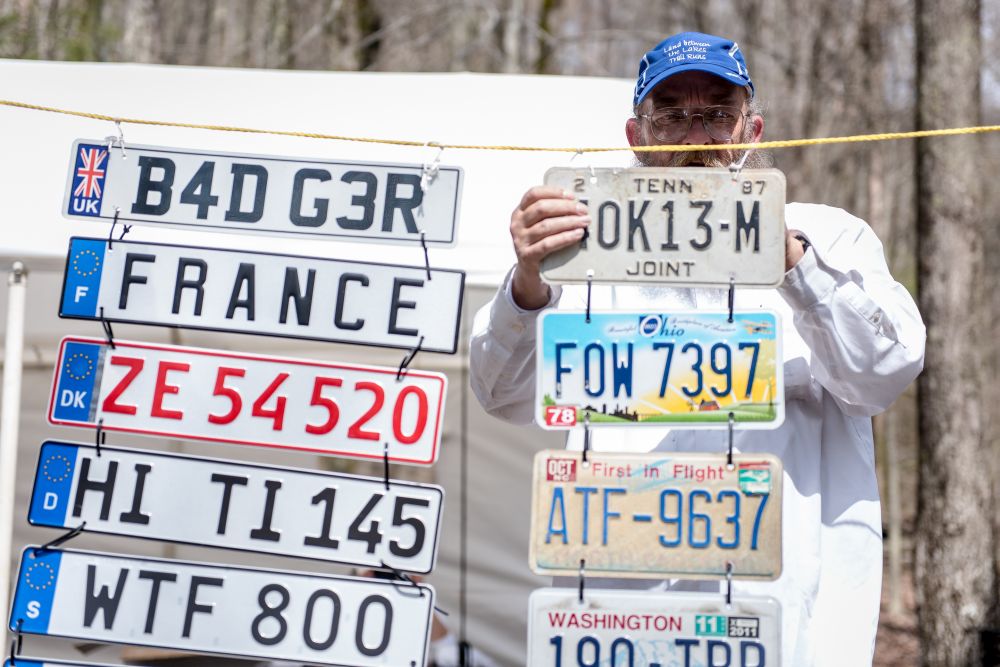
It’s one of the only races in the world where the organizers don’t expect there to be a winner, because in 36 years only 14 different runners have ever even finished.
It’s a race Robbins has had his sights set on for close to a decade, during which time he’s racked up an impressive ultra resume including holding the record for the Hurt 100 in Hawaii (a gruelling 100-miler that has a lower than 50 per cent finisher rate), a race he’s won three times now. He also has the fastest known time for the West Coast Trail on Vancouver Island, near his home in North Vancouver, and the Wonderland Trail around Mount Rainier, Wash.
And he’s going back to the mountains of Tennessee for nothing less than to finish all five laps and become the first Canadian to conquer the Barkley.
The early April race starts at an unknown time during a 12-hour window between 11 p.m. Friday and 11 a.m. Saturday, when Lake ceremonially lights a cigarette. In 2016, Robbins was restless after the long trip from Vancouver to rural middle America. When runners were called out of their tents with the one-hour warning before the start, he’d only slept an hour and a half. Robbins nevertheless immediately stepped up to join a lead pack of seven runners; a mix of virgins (as Lake lovingly calls first-timers) and veterans, led by by Jared Campbell, one of only two people to ever finish the race twice.
RELATED: Hallucinations, sleep deprivation and vertical cliffs: What the Barkley Marathons is really like
“It was pretty intense,” admits Robbins, “because everyone knows your best shot at a finish is to run at least one lap with a veteran, but Jared’s pace was way higher than anybody expected. This wasn’t anywhere close to 100-mile race pace.” Despite the pressure to remain with Campbell’s pack, Robbins describes that first lap as euphoric. “It was everything I wanted it to be,” he laughs. “When we reached the first book and I was tearing out my page I just remember thinking, ‘holy shit, I’m really in this. I’m really doing it.’”
By the start of lap two, Robbins was the only runner left who was willing or able to match Campbell’s stride and so the lead pack became a pair. Campbell had completed the race in 2012 alongside veteran Brett Maune, the only other person to finish the race twice. Campbell describes himself as “a student of the course,” and in 2014 his ambition was to complete it entirely under his own capability, which he did. In 2016, Campbell felt it was his time to become a mentor and give something back to the course by helping someone new to navigate it. “We made a good team,” Campbell says. “We were like a well-oiled machine,” agrees Robbins, and, for about three and a half laps, it seemed nothing could stop them.
Until, that is, night fell for the second time and the Barkley began playing mind games with the unfortunate few still vying to finish. It’s what the veterans call “second night syndrome.”
Losing It
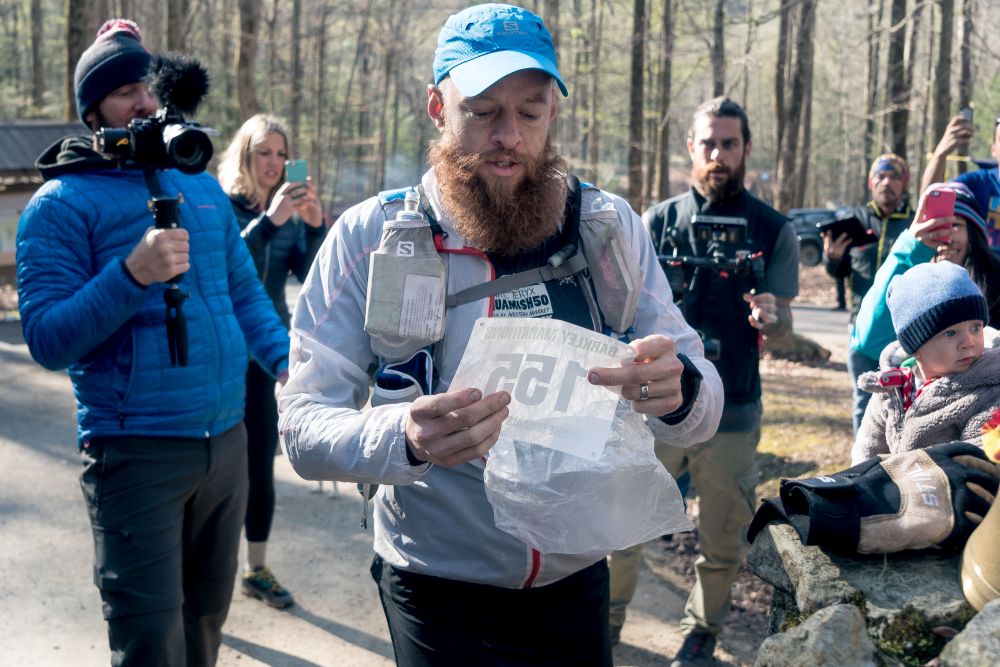
FORTY-SOMETHING HOURS into the race and it got ugly. Robbins was waist-deep in razor-sharp undergrowth and halfway up Bird Mountain for the fourth time. It was the dead of night, pitch black and bitter cold. All he could see was the sea of spiny bush, his own breath and Campbell’s back in the distance, illuminated in the beam of his headlamp. So far, the pair had covered more than 70 miles and 21,000 m of elevation together. More than 40 pages from 13 books were shoved into their packs. Over the course of these miles, they talked about their families, their wives, what they do when they’re not training for races, where they vacation and what sports teams they support. But Robbins had a problem. “I suddenly couldn’t remember who Jared was,” he says, “and that was my first warning that I was starting to lose it.” This memory glitch would be the small thread that would unravel the entire fabric of his sanity over the next 15 hours.
“By the fifth lap I was hallucinating pretty badly,” Robbins says. “I was seeing numbers on the trees and faces in the leaves on the ground. I saw my brother’s face on a rock at one point. Then I started hearing voices coming from the river. That was pretty disturbing.” By this point in the race, Robbins and Campbell had gone their separate ways, as the rules of the Barkley dictate that for the final lap runners must alternate which direction they run the course. Alone, sleep deprived and racing against the clock and his own mental deterioration, Robbins knew he would have to undertake an extraordinary and heroic feat to make the finish line. “Realizing that I was physically strong but that I still might not be able to hold it together long enough was something I’ve never experienced before,” he admits. “It was very frightening.”
RELATED: VIDEO: How Gary Robbins is prepping for Barkley Marathons
In the end, a basic navigation error near Brushy Mountain State Prison, a pivotal landmark in the course, would cost him two-and-a-half hours and, ultimately, his race. In the ensuing hours, a crazed Robbins tried desperately to cover ground fast enough to finish within the time limit. Through a series of “abrasive face-first falls,” he became “consumed” by the unforgiving terrain.
Finally, at 5:30 p.m. on April 4, 55 hours after the start of his race and 90 hours since he last slept, Robbins laid down in the dirt at the bottom of Rat Jaw Mountain, put his head on his backpack and accepted defeat.
Back to Barkley
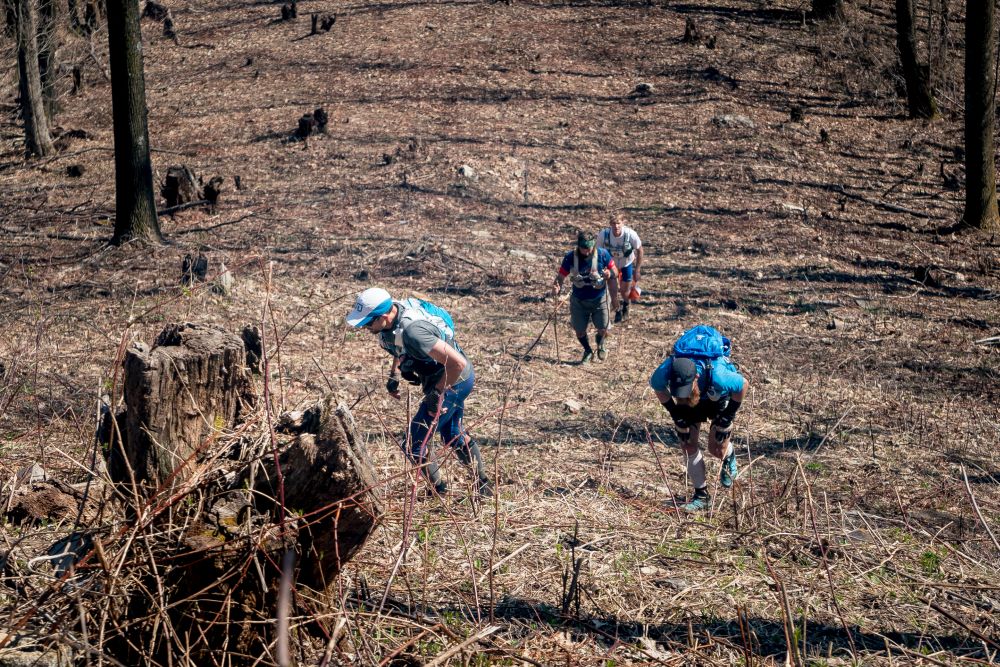
SIX MONTHS AFTER his Barkley attempt, Robbins finally began to feel normal again. It’s the longest recovery he’s ever had from a race that he says “physically and mentally destroyed me.” Coming to terms with his failure also meant coming to terms with the fact that he would have to return to undertake the race all over again, a decision he’d made within 24 hours of his crushing defeat at the bottom of Rat Jaw. “Barkley is just something that I have to do,” he says. “Would I be coming back if I’d finished the race in 2016? Nope, no way, never.”
While Robbins has kept much of his training schedule for 2017 the same as 2016, he says his motivations this year are very different. “It’s been hard to replicate the fear factor of the Barkley this time around,” he says. “Last year, it was such an unknowable beast and my training was largely driven by that. This year it’s not so much the race itself that scares me as the prospect of failing again. Knowing I’ll have to keep trying until I make it is terrifying,” he says, laughing. “I feel like I should get a reminder of that tattooed somewhere so I don’t forget that’s what I’m training for: to finish the race and not have to come back for a third time,” he adds.
Robbins’ training for the Barkley began in late January when he started to “load the vertical” by running reps on nearby Grouse Mountain, a 2.9k climb with a leg-burning elevation gain of 853 m that’s aptly dubbed the Grouse Grind. It’s where he’ll be doing the majority of his training. For many, one run up the Grind is a seasonal accomplishment. Robbins will do it a few times in one workout, and he’ll spend hours on the mountain in preparation for the Barkley. “It’s not the most exciting way to train,” he admits, “but Barkley is all about the elevation. Those are the only stats that matter. And in winter in North Vancouver there’s very few trails with good height gain where the snow’s been packed down.”
His training is supplemented by ski touring and ski mountaineering, which he recently started competing in with impressive success. (It’s hardly surprising given that his background is in expedition adventure racing.) A major difference in his preparation for the 2017 Barkley is that he’s allowed himself a ski season. “I didn’t do the Hurt 100 this year and instead I’ve been cross-training more, which I think will put me in a better place for this year’s race. I won’t be going into it on the limit, I’ll be a little better rested.”
In addition to his physical preparation, Robbins has also joined the Greater Vancouver Orienteering Club where he’s
been brushing up on his navigation skills. “Map and compass isn’t second nature to me,” he admits. “It’s something I needed to get better at so that, when I’m out there and I’m sleep deprived and exhausted, I can still put a
compass on a map and take a bearing.”
It’s a relentless preparation schedule for an athlete who is also co-founder of B.C.’s increasingly popular Coast Mountain Trail Series and has a 17-month-old baby at home. But if Robbins lives by one mantra it’s “tomorrow is promised to no one.”
“I turned 40 at the end of last year and I’m in the best shape of my life, but I’ve also suffered a long-term injury in the past so I’m not going to take anything for granted,” Robbins says. The injury he’s referring to is a twice-broken foot that prevented him from signing up for the Barkley in 2010 to race in 2011. He spent a year on crutches and was told that he may never compete in mountain sports again. “I can’t waste any year that I am physically healthy and able to train enough,” he says. “I know I have to take my chance to finish the Barkley while I have it.”
Robbins is also well aware that the Barkley is a race that is getting harder. Each time someone finishes, more elevation and distance are added to the following year’s race. Jared Campbell, who hopes to support Robbins’ effort this year before returning to race again next year, has already extrapolated his own finish times from 2012, 2014 and 2016 and concluded that, “if you look at the numbers, I shouldn’t be able to complete this race within the cut-off time in 2018.”
“That’s the scary thing,” says Robbins. “No other race in the world becomes more unattainable the more you fail to complete it.”
Barkley in the Blood
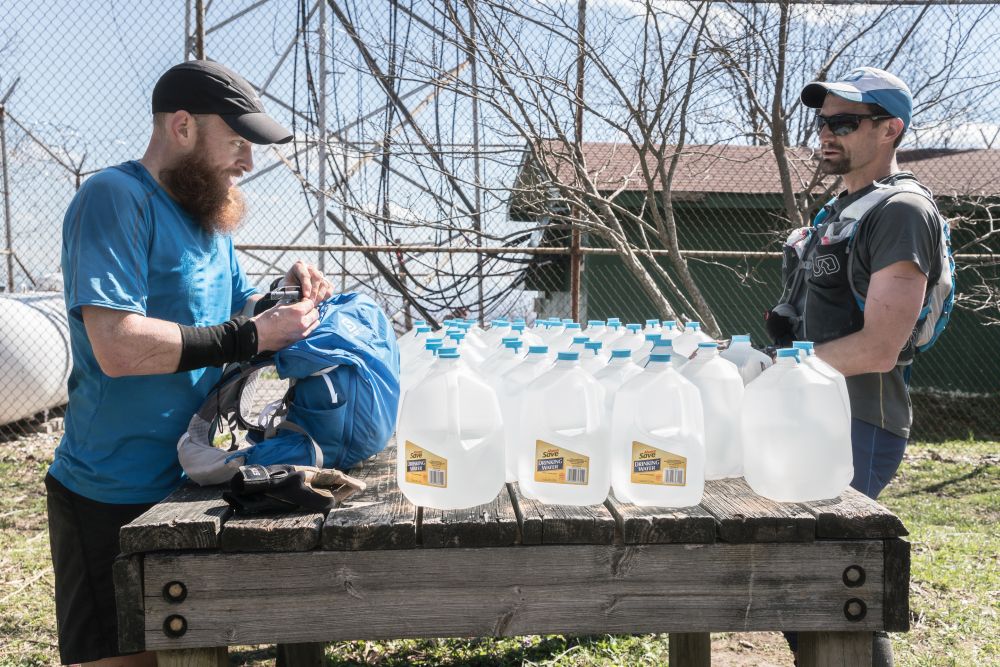
TO BETTER understand the allure of the Barkley, a race which seems to consume those unfortunate enough to secure a place with a feverish and single-minded obsession, I reached out to Arizona’s Ed Furtaw the original Barkley finisher who is preparing for his 20th race attempt this year.
“Barkley gets into your blood,” Furtaw says simply. “It’s less a race and more like a family.” Furtaw, who Lazarus refers to as a Barkley Elder, is better known among the Barkley family as Frozen Ed, a nod to Frozen Head National Park and a nickname he’s carried with him for nearly 30 years. At 69 years old, Furtaw’s attempt at this year’s race will be nothing short of extraordinary, but he admits he no longer races to compete. “It’s one of my favourite places in the world,” he says. “I love the landscape and the wilderness there. People describe the Barkley as brutal and terrible and it is, but it’s also very beautiful.”
During the race, Furtaw plans to scatter the ashes of his friend and fellow Barkley Elder, Stuart Gleman, who passed away in September 2016, a day after running 111 miles at A Race for the Ages, another race conceived by Lazarus Lake. Last year he scattered the ashes of another Barkley Elder, Chip Tuthill, in the same spot that has become known as the Barkley Memorial Cairn. “The good news is I’m still alive,” says Furtaw philosophically. “But the bad news is I’ve been running this race so long that all my friends are passing away.” But Furtaw is optimistic about the future of his beloved race and the continuation of the Barkley bloodline.
“Back in the ’80s and ’90s, Lazarus had 20, maybe 30 entries to the Barkley,” he says, “Now he gets over 1,000. The next generation of Barkley runners, and I hope we’ll be counting Gary Robbins in that generation this year, are incredibly important. Without people like Gary and Jared who are crazy enough to take it on, there is no race.”
Race of Fools
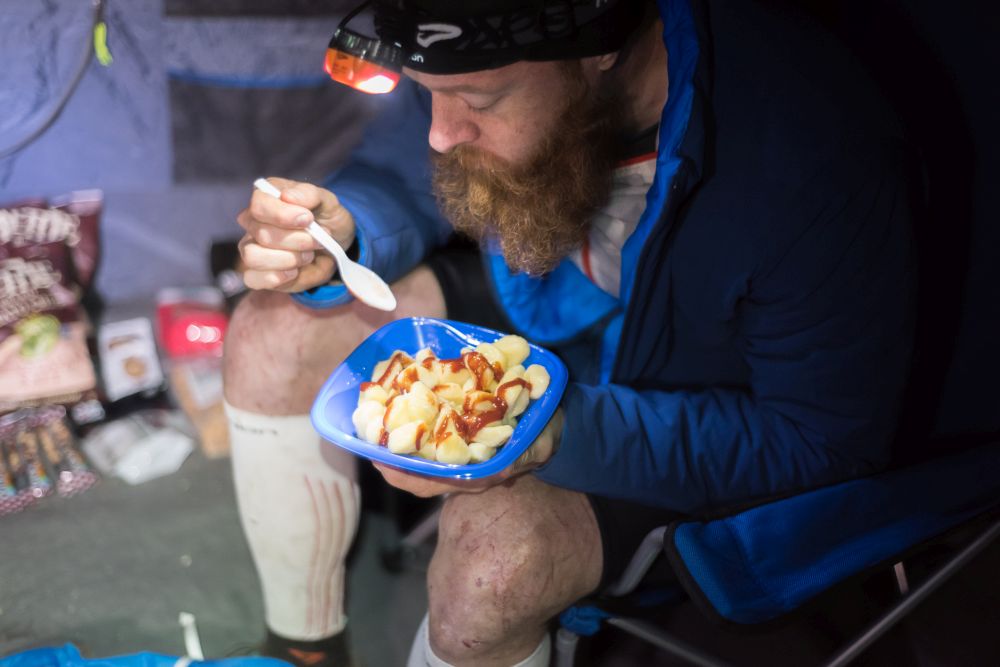
AN EMAIL LANDS in my inbox from Lazarus Lake. “You can reach me here,” is all it says.
It’s an appropriately enigmatic first contact from the Barkley Marathons race director who is notoriously hard to track down. We exchange a few emails and agree to speak on the phone at midnight in Lake’s time zone. As he only sleeps for four hours a night, he assures me it’s no trouble. Perhaps this explains why sleep was never factored into the Barkley Marathons.
An accomplished ultrarunner himself in his younger years, Lake held the inaugural Barkley Marathons, a 50-mile race, in 1986. The 100-mile version of the race wouldn’t be held until 1995 but the purpose has always been the same: “pushing runners beyond what they believe to be physically and mentally possible.” Each year, on what Lake calls “Fools Weekend,” he watches his hand-picked field of hopefuls set off while he waits by the yellow gate, watching his race unfold and its runners unravel. From here, he has seen every triumphant finisher’s return and every humbled quitter’s retreat.
“It’s a pretty interesting place to stand,” he admits in an easy Tennessee drawl. “You see these runners come through and they have all these terrible things wrong with them and they’re trying to fix themselves up enough to go back out there.”
“Quitters always look the same,” he confides. “Just washed out physically and emotionally drained. Usually their mind goes and that’s what causes them to mess up. That’s what happened to Gary. If he could have thought clearly, he could have fixed his mistake but he couldn’t.” His matter-of-fact explanation of Robbins’ story is typical of Lake’s way of telling the stories which have defined the race over the years. He is unsympathetic towards failure. Perhaps that’s to be expected from a man who has witnessed so much of it over the past 30 years. “I’ve seen people only manage a couple of miles, get completely lost and then wind up right back in camp. They’re usually relieved to be back too,” he says. But when I ask about his favourite winners moments, Lake’s matter-of-fact tone changes to something not unlike admiration. “When someone finishes five laps, it’s incredibly inspiring,” he says. “The fact is that everybody that’s finished this race has had to complete the fifth and final lap faster than the fourth one. Which
means you have to be just a little bit super-human.”
I ask Lake if he can reveal anything about what Robbins and the rest of the field can expect from this year’s race which, because of Campbell’s finish last year, will almost certainly be longer, higher and harder than before. “Well,” he drawls, “we’re not sure if we’ll add any more elevation this year. We think that might be unfair on the runners.” He pauses for dramatic effect and I sense there’s a “but” coming. “But we’ll definitely be adding some more downhill and you can pass that information on to Gary. We think he’ll be pleased. We’re looking forward to having him back.”
-Author Sharon Crowther has run trail races all around the world. She has called Scotland, Calgary, and now Malaysia, home. She regularly contributes to Canadian Running
